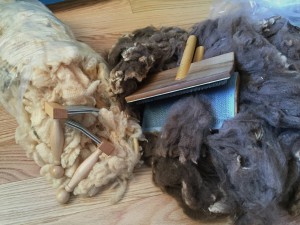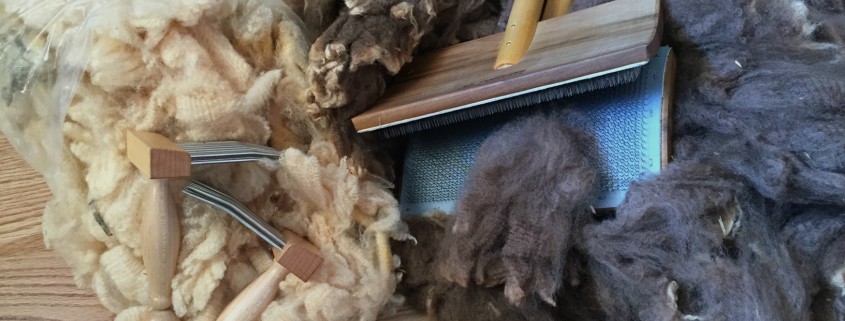A Little Itch
 Earlier this week I woke up wanting to process raw fleece. It’s not what I usually do, it’s not what I’m drawn to spinning-wise. I’m a commercially prepped, gorgeously hand dyed fiber kind of spinner. But lately I’ve been thinking about fleece.
Earlier this week I woke up wanting to process raw fleece. It’s not what I usually do, it’s not what I’m drawn to spinning-wise. I’m a commercially prepped, gorgeously hand dyed fiber kind of spinner. But lately I’ve been thinking about fleece.
Actually the little fleece itch started this summer when I was wading between bags of fleece with Beth Smith at the Michigan Fiber Festival. There were these beautiful CVM fleeces that not only called my name, but sang to me like Marvin Gaye. I didn’t buy one. I got a bunch of other spinners to buy them, so I know they went to good homes. I still think about those fleeces.
Lately my spinning ‘what-ifs’ have included prep, and not just carding commercially prepped top either. I’ve been thinking about sinks full of fleece and fleece drying on screens in the back yard. Dreaming about carding and combing fleece and spinning it all every which way. Right now it’s just an itch, a persistent itch. If I know my rabbithole leaping ways, soon I’ll be adding fleece to my stash. I may practice on those two up there – a little Gulf Coast and a little Bond I have tucked away. PLY AWAY is next week and I’ll bet there might be a few fleeces in the marketplace………
What fleeces do you have in your stash?




Two Shetland, two mohair, one coopworth, one Southdown/ Suffolk and one alpaca!
Just had five Shetland fleeces spun by a mini mill to decrease the fleece hoarding before NH Sheep and Wool Festval May 14,15
We don’t list the fleeces in my stash because that would be scary. But I will tell you that I have a happy medium. I adore buying fleeces and spinning fiber that I bought as fleece. Often from animals that I know the name of and are raised local to me. But I loathe washing and prepping fleece. To the point where I would rather give up spinning forever. The happy medium is that I have a local small mill who preps my fleeces for me. I have them washed and carded into roving. Often blended with stuff. Then if I want to spin fleece it is ready to go and if I want to make batts or top, it’s still ready to go.
As I mentioned on Facebook, I am drawn to alpaca fleeces since several friends raise alpacas and shearing is just finished. Last week I brought home 6 bags of raw alpaca fleece (240-350g each) that I will “card” on the blending board and then spin – corespin for the shorter, regular spin for the longer. These fleeces pretty clean, just a bit of fine sand and a few bits of vegetable matter (mostly hay). For a fuzzy worsted yarn, I will core spin from raw fleece. Of course, that means lots of cleaning for my wheel, floor, pants, feet, hands.
To wash I have a fine merino and a large Corriedale. There are several others washed and waiting. Need to get to work!
5 Shetland (from Shetland), 1 Cormo, 1 CVM, 1 Merino-Falkland cross.
I love the control it gives me from the very beginning. I have several fleeces under my bed and a couple partial ones in my back room. I own angora rabbits too, so I have that fiber running around already.
Washing is intensive, but therapeutic for me. It’s also a great way to feel like your doing something, with plenty of downtime between each rinse.
I have been working on a lovely natural black rambouillet that fluffs up so soft even spun in worsted.
I’ve got two Shetland fleeces (another off a sheep tomorrow, yay fresh shearling) and most of two alpaca fleeces waiting to be spun.
I like the control aspects of processing fleeces from the raw, but primarily it’s the money. Raw fleece tends to be cheaper by the pound rather than cleaned roving.
I have a cormo fleece that I have scoured, but not yet combed or carded, and a finnsheep that has been scoured and carded. I am trying to decide if I want to blend the finn with something, perhaps camel. Right now it is all possibility.
I love to process my own… I have done whole fleeces of merino, English Leicester, Finn,Gotland, Polwarth, and around 30 suri & huacaya alpaca…you really can’t compare…the fibre remains ‘alive’, you get to know each style intimately & what works best, slow fibre production is extremely satisfying to me, however, while I am waiting for fleece to soak, wash, dry , I do love a well prepared gorgeously dyed top or roving to spin.
About nine million Shetland fleeces hoarded from my own flock, various other breeds also represented. I learned to spin in 1987, when processing raw fleece was about the only option. The ultimate luxury for me is to hand card and spin a whole fleece.
I’ve been spinning raw angora I collect from my cute rabbits and I love it! There’s something about being apart of the process from the very beginning. Absolutely love it!
When prep fleece myself I feel closer to the sheep to shawl history and can put to use all the night time reading of “this fibre spun that way, worsted, woolen, semi-worsted”. It’s made me a better spinner and then when it comes to the luscious dyed tops, it’s such a treat.
Only trouble is, with all the prepping effort, I’m terrified to dye it.
I love to prep raw fleece! I love the sheepy smell of it, the process of washing it, and seeing the transformation from dirty raw fleece to beautiful clean spinning fiber.
I had JUST winnowed down my raw fleece stash, but visited a shepherd friend this week and retuned with a van-load full. 🙂
Currently in my raw fiber pantry:
Rambouillet
Teeswater
Gotland/Wensleydale cross
Bond/Rambouillet cross
Mohair
Romney
Wensleydale
Merino
Oh, and Alpaca!
Hah. I took home one of those fleeces from Allegan and it’s washed but still needs to be processed. More than I’ve ever done and a little intimidating.
I have so many fleeces (of many varieties) that I feel it would be like revealing something a little too private. 🙂 to give you an idea, I recently did a rough estimate–each year, I teach at least a couple of workshops, and I think I have given away roughly 50 lbs of both roving (processed from raw fleeces I acquired) and raw wool/washed wool to my students as part of their materials fees. Also, about five years ago, I had twins, and now only acquire a fleece or two a year. So the stash is deep. I too learned at a time when mostly fleece –and occasional compacted roving -was available, roughly the mid ’80’s. I like processing from scratch, and I do not mind sending the wool to a processor when things get out of hand, like when I get 50 lbs or more of raw wool at a time! (I have moved to Canada, and find the postage and border gets in the way sometimes though…)
Anyhow, I guess this is all to say that I find great joy in getting to know the actual animal first at the shearing, a raw fleece, in hand processing, and in knowing I did it all or mostly all from scratch.
It might help also to know that I am just not that into knitting with variegated yarns, either, although I can certainly dye and spin them!